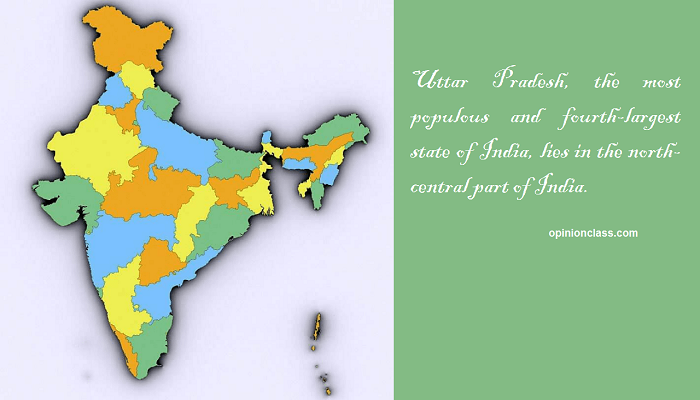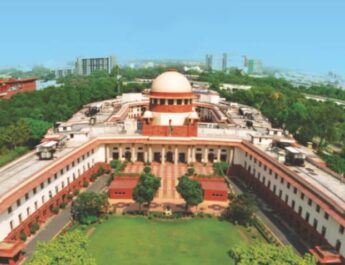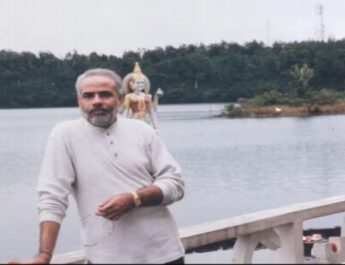Uttar Pradesh, the most populous and fourth-largest state of India, lies in the north-central part of India.
Uttar Pradesh, a home to the world’s largest number of poor, is bordered by Uttarakhand and the country of Nepal to the north, Bihar to the east, Jharkhand and Chhattisgarh to the southeast, Madhya Pradesh to the south, Rajasthan, Haryana and Delhi to the west. The state’s capital Lucknow, the west-central part of the state, covers the area around 93,933 square miles (243,286 square km).
After the independence, the state was given its present name Uttar Pradesh (literally, Northern State) on January 26, 1950, by its first chief minister, Govind Ballabh Pant.
Because of its strategic and prominent position in the Indo-Gangetic plains, Uttar Pradesh remains the epicenter of the historical advances in India.
Uttar Pradesh was formerly occupied by the Aryans, who had later laid the foundations of their civilization in the region. Notably, their main occupation was agriculture. However, it was the centre of Aryan inhabitation that epics of Mahabharata, Ramayana, Brahmanas and Puranas were written.
In the 6th century, Uttar Pradesh was associated with two new religions- Jainism and Buddhism. Lord Buddha delivered his first sermon at Dhamek Stupa in Sarnath during Magadh rule in India. At the same period of time, Ayodhya, Prayagraj, Varanasi and Mathura had become reputed centres of learning in India.
In the medieval period, Uttar Pradesh passed under Muslim rule Mughal emperors Babur and Humayun. In 1540 an Afghan ruler, Sher Shah Suri, took over the reins of Uttar Pradesh after defeating the Mughal ruler Humayun. The conquer led the way to a new synthesis of Hindu and Islamic cultures.
In this period of time, Ramananda and his Muslim disciple Kabir, Tulsidas, Surdas and many other intellectuals contributed to the growth of Hindi and other languages.
The seventh century witnessed the taking over of Kannauj by Harshavardhana. In 1526, Babur laid the foundation of the Mughal dynasty. He defeated Ibrahim Lodhi in the battle of Panipat. Babar carried out an extensive campaign in various parts of Uttar Pradesh. He defeated the Rajputs near Fatehpur Sikri while his son Humayun conquered Jaunpur and Ghazipur, after having brought the whole of Awadh under his control. After Babur’s death (1530), his son Humayun forfeited the empire after being defeated at the hands of Sher Shah Suri at Kannauj.
During the British rule in India, there were certain area in Uttar Pradesh that were governed by English equity and common law. In 1773, the Mughal Emperor transferred the districts of Banaras and Ghazipur to the East India Company. The East India Company acquired the area of modern-day Uttar Pradesh over a period of time. The territories occupied by the nawabs, the Scindias of Gwalior and the Gurkhas were initially placed within the Bengal Presidency.
Population
Uttar Pradesh, India’s most populous state, has a population of 199,581,477 million as of March 1, 2011. However, it is the fourth largest state of India in terms of area. If Uttar Pradesh would be a separate country then it would be the world’s fifth most populous country after China, India, the United States and Indonesia.
The vast majority of the people are Hindus while Muslims are the largest religious minority in the state.
As per the 2001 census, about 80% of the Uttar Pradesh population is Hindu, while Muslims contributed 18.5% to the population of the state. The remainder consists of Sikhs, Buddhists, Christians and Jains.
Language
There is a famous quote in Hindi that Char kos par badle pani, 8 kos par vaani (Water changes at every 4 Km. And Language changes at every 8 Km). There are approximately 29 languages spoken in Uttar Pradesh.
Hindi, which is spoken by 91.32% of the state’s population, is an official language of Uttar Pradesh but Hindi has too different subgroup and changes it variant place to place.
Urdu is co-official language because of the presence of large Muslim population in the state. The vernacular Hindustani is widely understood.
The term Hindi covers so many dialects such as Avadhi, Braj, Bundeli, Bagheli, Kannauji and Bhojpuri and such dialects may or may not be considered as separate languages and may or may not be fully mutually intelligible. Especially the status of Bhojpuri as a dialect of Hindi language is subject to great debate.
In uttar pradesh, Khadi boli, Kannauji, Braj spoken in western, Awadhi in centre, Bundeli in southern, Bhojpuri and Bagheli in eastern part of Uttar Pradesh.
The languages of Uttar Pradesh generally belong to two zones in the Indo-Aryan languages, Central and East.
Rivers
Uttar Pradesh has 31 rivers and major of them are Ganga, the Ghaghara, the Yamuna and the Sarayu flow though this state.
Among these rivers, the Ganges (Ganga) and Yamuna are the major two rivers of Uttar Pradesh and the Ganges is the longest river of the state.
The other rivers are Ramganga, Gomati, Ghagra, Gandak, and the tributaries of Yamuna like Chambal, Betwa, Sind, Ken. Most of the rivers are meet with Ganga. The rivers are perennial, snow fed and emerged from Himalayas except Gomati.
The UP rivers can be divided into three parts based on the point of origin.
Rivers originating from the Himalayas are the Ganga, Yamuna, Kalli /Sharda, Ramganga, Ghaghra and Gandak.
Rivers originating from plains of Uttar Pradesh are Gomti, Varuna, Pando, Isan, Rihand.
Rivers originating from the south plateau are Chambal, Betwa, Ken, Son, Tons and Kanhar
Tourism
Uttar Pradesh is considered as the spiritual backbone of the country with places like Varanasi (the spiritual capital of India), Allahabad (the most auspicious of the four Kumbh Mela sites) and Mathura and Vrindavan (home to Lord Krishna) and Sarnath where Buddha preached his first sermon.
Uttar Pradesh is the recipient of a high number of tourist footfalls every year. Many visitors flock to Hindu centres such as Varanasi, Allahabad, Ayodhya and the Mathura-Vrindavan area; Buddhist centres such as Sarnath, Kasia (site of Kushinagara, where the Buddha died), and Shravasti; and other historic places such as Agra, Lucknow, and Kannauj.
Uttar Pradesh has one of the most beautiful wonders of the world Taj Mahal due to which on an average 2 million domestic and foreign tourists visit Uttar Pradesh every year.
Economy
Uttar Pradesh is the second largest economy in India after Maharashtra which is the largest economy of India, roughly 1.8 times that of UP.
Agriculture is the primary contributor in the economy of the state and it’s also known as the Rice bowl of India. Uttar Pradesh is the largest producer of food grains and vegetables in India. The chief crops are rice, wheat, and sugarcane. Since the late 1960s, with the introduction of high-yielding varieties of seed for wheat and rice, greater availability of fertilizers, and increased use of irrigation, the state has become a major producer of food grains in the country. Livestock and dairy farming often provide a supplementary source of income.
Uttar Pradesh is recognised as a major milk-producing state in India. Milk production in the state stood at 30.5 million tonnes in 2018-19, accounting for 16.50% of the total milk production of the country. Per-capita milk availability in the state stood at 359 grams per day in 2018-19.
Transportation
Uttar Pradesh is connected by a vast network of roads, including a number of national highways, and railways. The state is well connected to its nine neighboring states Haryana, Delhi, Rajasthan, Uttarakhand, Bihar, MP and Chhattisgarh and almost all other parts of India through the National Highways. There are total 42 national highways connecting Uttar Pradesh.
Major cities in Uttar Pradesh are connected by air to Delhi and other large cities of India. The three inland waterways of the Ganges, Yamuna, and Ghaghara rivers also are an integral part of the state’s transportation system.
Uttar Pradesh has the largest railway network in the country as the the state had was established the Uttar Pradesh State Road transport corporation (UPSRTC) in the 1972 to provide reliable, economic and comfortable transportation in the state with connecting services to adjoining states.




